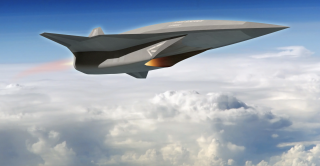Faster: Meet the Air Force's New Mach 5 SR-72 Spy Plane
Can't stop this.
“Hypersonics is like stealth. It is a disruptive technology and will enable various platforms to operate at two to three times the speed of the Blackbird,” Carvalho told Aviation Week. “Operational survivability and lethality is the ultimate deterrent. Security classification guidance will only allow us to say the speed is greater than Mach 5.”
The successor to Lockheed Martin’s SR-71 Blackbird, the Mach 3 long-range recon aircraft that once tore across the skies like a Cold-War era arrowhead before its retirement in 1999, may be inching closer toward reality.
According to Aviation Week, a handful of visitors to the SAE International Aerotech Congress and Exhibition at Fort Worth, Texas, this week reported catching glimpses of a “demonstrator vehicle” believed to be linked to the proposed replacement: the SR-72.
(This first appeared in Task and Purpose back in 2017 and is being republished due to reader interest.)
Though the SR-72’s development is (understandably) a tightly-kept secret, Aviation Week reports that: In the early hours of July, an “unmanned subscale aircraft” was seen flying into the Air Force’s Plant 42 in Palmdale, California, where Lockheed Martin’s legendary Skunk Works division is headquartered.
With an “optionally piloted” flight research vehicle test slated for 2018 by Lockheed back in June, and a test flight anticipated to occur by 2020, the presence of the demonstrator at Palmdale seems to indicate that the SR-72’s progress is in line with Lockheed Martin’s timeline.
“Although I can’t go into specifics, let us just say the Skunk Works team in Palmdale, California, is doubling down on our commitment to speed,” Orlando Carvalho, the executive vice president of aeronautics at Lockheed Martin, said at the exhibition, which ran from Sept. 26 to 28. “Simply put, I believe the United States is on the verge of a hypersonics revolution.”
Lockheed Martin has remained tight-lipped on the SR-72 program since announcing the Blackbird successor in 2013, but the aerospace giant wants to up the ante in terms of speed. And that’s saying something: the Blackbird as it's known is not only faster than any other jet-propelled aircraft — it can literally outrun missiles.
“Speed matters, especially when it comes to national security,” as Carvalho put it.
If the recent sightings in Palmdale are tied to the Blackbird’s replacement, then the aircraft really is fast — and not just on the flight line. While still under development at Skunk Works, the proposed reconnaissance plane is expected to hit Mach 6 thanks to advanced new hypersonic tech.
“Hypersonics is like stealth. It is a disruptive technology and will enable various platforms to operate at two to three times the speed of the Blackbird,” Carvalho told Aviation Week. “Operational survivability and lethality is the ultimate deterrent. Security classification guidance will only allow us to say the speed is greater than Mach 5.”
The proposed hypersonic aircraft could fill a space left by the SR-71, which was retired in 1999 due to the proliferation of spy satellites, enemy air defenses, and ultimately, its exorbitant costs — roughly $200,000 per hour of operation, reports the National Interest. Unlike its predecessor, the SR-72 is being designed with strike capability in mind — which means it’s not just a super speedy spy plane: It can reach out and touchobliterate a target, then zip back the way it came.
Carvalho’s comments, while not explicitly linked to the SR-72, mirrored sentiments expressed by Rob Weiss, executive vice president and general manager of Lockheed Martin’s Advanced Development Programs organization, during the American Institute of Aeronautics and Astronautics forum in Denver, Colorado in June.
“We’ve been saying hypersonics is two years away for the last 20 years,” said Weiss. “But all I can say is the technology is mature and we, along with DARPA and the services, are working hard to get that capability into the hands of our warfighters as soon as possible.”
Image: Lockheed Martin.

